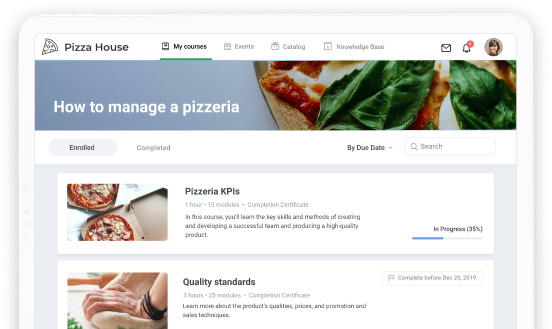5 LearnDash Alternatives: Top 5 Picks
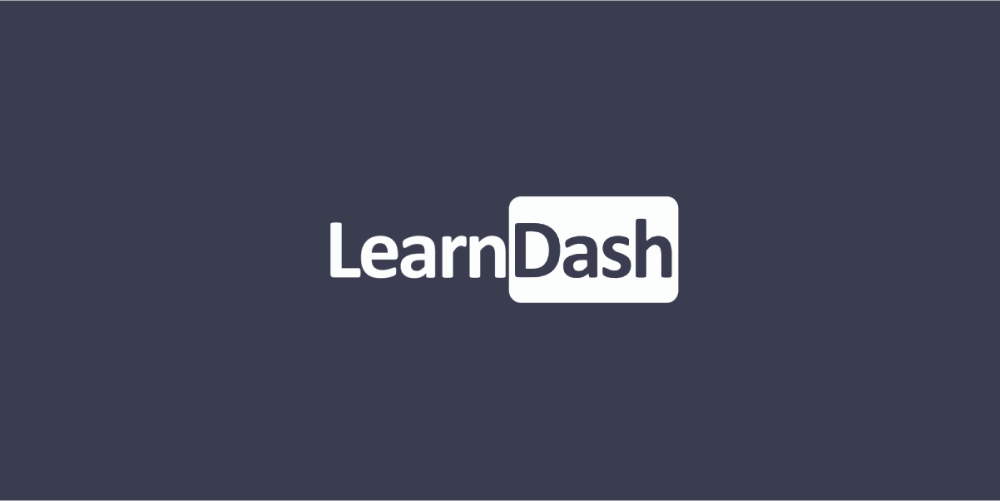
Whether you’re a small education business or an entire training center, picking the right platform for selling courses will fall on your shoulders. However, in a market flooded with hundreds of options, it’s easy to feel lost. To lighten the load and narrow down the options, you might opt for the biggest names in the game, like LearnDash.
LearnDash is undoubtedly a top-grade option that ends many people’s searches, but it’s best not to be rash. There are several LearnDash alternatives that can offer more bang for your buck depending on your unique business needs.
Well, we’ve made a detailed comparison of these alternatives. But first, we’re going to review LearnDash to provide a frame of reference.
LearnDash Review
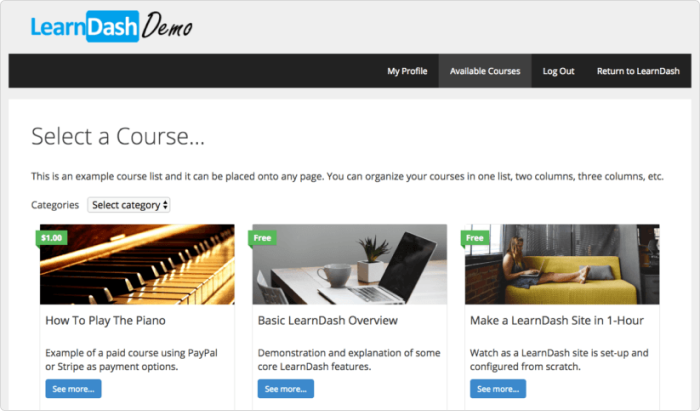
LearnDash is a plugin that allows you to create, market, and sell online courses from the convenience of your WordPress dashboard. It leverages the powerful features of WordPress to develop and sell eLearning courses and promises a high level of flexibility and vast customization options.
For example, WordPress gives you access to over 10,000 different themes for your LearnDash courses and marketplace. And if you require a little tweaking, then you can customize your web pages via HTML or CSS – if you’re a programming buff. Moreover, because it offers a wide assortment of integrations, you’re free to add or remove courses and marketplace functionalities as you see fit.
Course creation
If you know how to create webpages and blog posts with WordPress, then you’ll find LearnDash’s course creation interface to be familiar and easy to navigate. The course editor looks exactly like the WordPress editor and can be accessed the same way.
LearnDash supports virtually every content type, including:
But note that, if you plan to have a lot of large audio and video files, you’ll have to use an external service, like YouTube or Wistia, and embed them externally from these sites.
LearnDash has a simple drag-and-drop interface, allowing you to organize your courses into modules, lessons, lesson sections, and lesson topics. You can also create quizzes using their Quiz Builder. However, to truly leverage the power of quizzes, you’ll have to pay for their Plus or Pro plan to access ProPanel, a helpful tool for garnering insight into your content, user progress, and quiz results.
Marketing and selling
LearnDash helps create powerful marketplaces because there’s an integration for virtually everything, including your payment gateway, course memberships and bundles, email campaigns, and affiliate marketing. Simply choose one of many integrations, such as WooCommerce, Easy Digital Downloads, and Samcart, and incorporate or build your brand from there.
They also offer multiple payment gateways for fixed-price and membership courses, with many ways to discount your courses and increase sales. And for reporting and analytics, LearnDash integrates with Google Analytics for user and site data.
What LearnDash is best suited for
If you have a WordPress site and would like to host your courses and other business activities all in one place, then LearnDash is a reliable option. However, it’s not the simplest interface to navigate if you’re starting out with WordPress for the first time. So if you’re keen to develop and sell courses as soon as possible, this might not be the best option.
Pricing
LearnDash has 3 pricing plans – Basic, Plus, and Pro. The main difference is the number of site licenses allotted per plan, and whether or not you get access to ProPanel. Currently, the pricing is as follows:
- Basic Plan: $159/year. This plan gets you 1 site license, and everything the Pro and Plus plan have. However, you need to upgrade for ProPanel.
- Plus Plan: $189/year. In this plan, you get everything in Basic plus 10 site licenses and Pro Panel.
- Pro Plan: $329/year. Everything here is the same as the Plus plan, except you get 25 site licenses.
1. iSpring Market

iSpring Market marries simplicity with functionality, which is why it is a fantastic alternative to LearnDash. You can literally create and start selling courses in a snap! Simply upload your content and build your storefront in only a matter of minutes.
Moreover, unlike many similar platforms, iSpring Market is a fully-functional LMS – it allows you to not only create courses but also manage learners and the entire training process. For example, you can assign different roles to users, add them to groups, and monitor data not only from a sales revenue perspective but from a learner progress perspective as well.
Course creation
It’s super easy to create online courses with iSpring Market. The platform offers unlimited bandwidth and storage, eliminating the need for a 3rd party host. And it supports virtually any content type, such as:
- SCORM 1.2/2004 packages
- MP4 videos
- FLV videos
- MP3 audio
- Digital downloads (PDF, DOC, XLS, PPT)
Whatever the file type, simply upload your content, organize it into folders, and create lesson hierarchies as well as user-specific learning paths. Once users complete a learning path, iSpring Market automatically issues certificates.
Marketing and selling
As soon as you upload your course to the marketplace, it’s indexed by Google and Bing, maximizing your visibility and, thus, sales potential. With only a couple of clicks, you can begin incentivizing your customers with discounts, coupons, or freebies. To incorporate business branding, you can customize your storefront by adding your logo, changing the color scheme, and/or using your own domain name.
iSpring Market allows you to accept multiple currencies and offers a wide selection of payment gateways, including Authorize.Net, Stripe, credit card, and PayPal.
What iSpring Market is best suited for
iSpring Market is a solid bet if you’re a training center or business looking to sell online courses quickly. It makes life especially easy when you have pre-existing content that simply needs to be uploaded to a host, organized into a structure, and searchable on major search engines. It is also the perfect solution for companies who’d like to provide professional certification programs. The platform will help you ensure that each learner has viewed the learning material, allow you to check their test grades, and issue completion certificates to the learners.
Pricing
The iSpring Market pricing plans vary depending on how many users or subscribers you have on your course. The prices shown are billed annually.
- 500 users, 25 Gb for $37/mo ($444 per year).
- 1,000 users, 50 Gb for $77/mo ($924 per year).
- 2,000 users, 100 Gb for $247/mo ($2,964 per year).
2. Thinkific
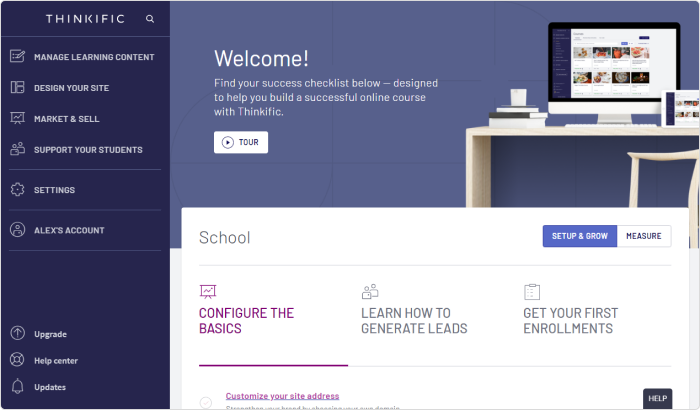
Thinkific is a cloud-based platform that requires minimal technical skills. It does the heavy lifting for site hosting, security, and updates, thereby allowing you to focus on content creation and sales. It is also largely intuitive to use due to its drag and drop course editor. Whether your courses are highly customized, or you need rich marketing and sales features, Thinkific is a solid LearnDash alternative.
Course creation
Thinkific is similar to iSpring Market in that you need pre-existing content to upload. Moreover, afterward, you can simply rearrange and structure your courses with the drag and drop editor before putting it on the market. Thinkific also offers a handful of course templates that you can choose from to help you get started.
The platform supports the following content types:
- MP4 videos hosted on Wistia
- MP3 and WAV audio
- HTML5
- Any content that can be added as an iFrame
You can add your content in bulk using the Bulk Importer. That way, if your course is comprised of many different file/lesson types, then you won’t have to tediously add one file type at a time.
You can also feel free to either import your quiz questions or build multiple-choice quizzes right out of the platform.
Marketing and selling
Due to Thinkific’s Site Builder feature, you have a moderate level of customization options at your disposal. While you can’t use CSS to customize your home and sales pages, you still have a wide range of options regarding the color theme, fonts, media, and adding your logo. The Site Builder also allows you to choose from 3 attractive templates.
Furthermore, Thinkific has all the hallmarks of a solid platform from a sales perspective. You can offer courses for free to incentivize new buyers or offer discounts/coupons. You can also offer courses on a fixed-price, subscription, or membership model. And, like LearnDash, Thinkific offers handy integrations – payment gateways like PayPal and Stripe or email marketing tools like ConvertKit or ActiveCampaign. The more you pay, the more (and better) integrations you unlock.
What Thinkific is best suited for
Thinkific is great for someone who doesn’t want to think too much about the techy stuff. While Thinkific offers advanced CSS customization options for its sales pages, it is relatively limited, and better for someone who’s not too particular about technical details. As such, this eLearning platform tends to be geared towards entrepreneurs or smaller businesses whose focus and brand are centered on online course creation and course promotion.
Pricing
Thinkific has 4 pricing tiers; all billed on a monthly basis:
- Free plan: $0. It allows you all the basic features, such as content hosting, creating quizzes/surveys, and unlimited students. However, you’re limited to hosting three courses until you upgrade.
- Basic plan: $39. It includes everything in the free plan and more. For example, instead of only 3 courses, you can host an unlimited amount – as per all paid plans. It also tacks on marketing and sales features such as email integrations, Zapier triggers, and custom domain names. Moreover, with this plan, you can automate certain administrative tasks such as auto-enrollment and sending student emails.
- Pro plan: $79. It includes everything in the basic plan but unlocks extra courses and e-commerce features, such as adding up to 2 site admin accounts and 5 course admins, creating memberships, issuing and receiving assignments, and advanced customizations. This is by far the most popular plan.
- Premier plan: $399. This package is known as their unlimited growth package. It includes everything in the Pro plan but allows for 5 site admins, 50 course authors, and 15 group analysts. You also get single sign-on capabilities and an onboarding package.
3. Teachable
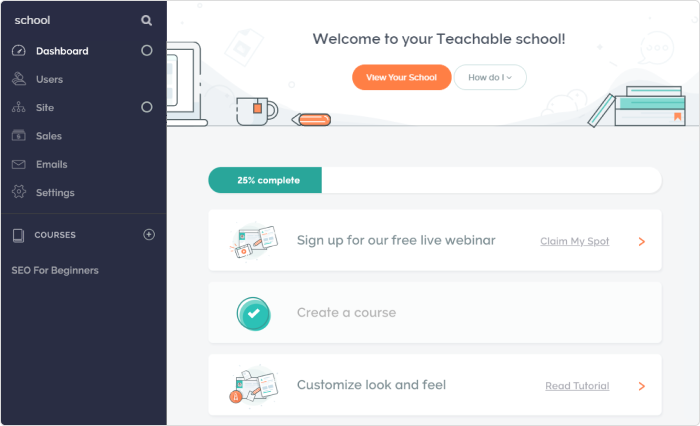
Teachable is a cloud-based platform solution that competes nose to nose with Thinkific. They’re long-time rivals. As a result, there is a lot of overlap between these two platforms. As with iSpring Market and Thinkific, Teachable takes care of the dirty work — the site hosting, updates, and security — so that you can focus on creating your courses and making money.
Its website interface is clean, and it offers a relative degree of customization options – less than LearnDash but more than Thinkific. You don’t need to be a coder to get the most out of this site. Interestingly, despite the scope of similarities between Thinkific and Teachable, Teachable’s price point is noticeably lower.
Course creation
Creating courses in Teachable is straightforward and follows the standard procedure. Simply upload your content – Teachable accepts your standard content types:
- mp4, MOV, or AVI video
- PNG or JPG images
- mp3 audio
However, as with Thinkific, it doesn’t have support for SCORM or Tin Can packages. Therefore, you won’t be able to host content from authoring tools like iSpring Suite or Articulate Storyline. This might be restricting depending on whether you wanted to incorporate high interactivity in your courses.
Once your content is uploaded, you can organize it into “sections” and “lectures” – otherwise termed as modules and lessons, respectively. As for Teachable’s quiz features, they are quite limited and only offer multiple-choice questions.
Marketing and selling
Teachable and Thinkific are also close contenders in the marketing and sales realms. Teachable also sells fixed-price, subscription-based, or membership courses, and offers you the flexibility of course bundles, coupons/discounts, and free courses. However, its sales page features are highly customizable and create an environment for easy conversion. For example, with Thinkific, customers walking through your sales funnel have to create an account before accessing the payment page, whereas Teachable lets customers find your courses and pay all on one page.
That being said, Teachable falls short in the website design and customization arena. While Thinkific offers 3 themes, Teachable only offers one. And while the branding options are the same as Thinkific, Teachable sets itself apart by allowing for HTML/CSS coding on each webpage.
What Teachable is best suited for
For the most part, Teachable and Thinkific cater to similar audiences – training centers and companies who’d like to sell courses without dwelling too much on the course building features. So, if you’d like to play interactive content, you’re out of luck. Without support for SCORM or Tin Can packages, you’re better off only creating courses with standard multimedia. As a matter of fact, a good portion of Teachable’s users create video-based courses!
Pricing
Unlike Thinkific, Teachable doesn’t have a free plan. Nevertheless, it offers a cheaper basic pricing plan (billed annually):
- Basic. $29/month.
- Professional. 79/month.
- Business. $399/month.
Each plan includes unlimited file storage and bandwidth, integrated payment processing, basic quizzes, and student management. However, the Basic plan includes 5% transaction fees, unlike the upgraded plans.
The Professional plan has everything in the Basic plan, plus extra course design features like graded quizzes and completion certificates. It also gives you a marketing edge due to advanced theme customization and a brandable website.
Then there’s the Business plan, which includes everything in the Professional plan, but instead of 5 admin users as in the Professional plan, it allows for 100 admin users. Moreover, it tacks on extra features such as manual student imports and bulk enrollment, thus making it the better choice for organizations.
4. Podia
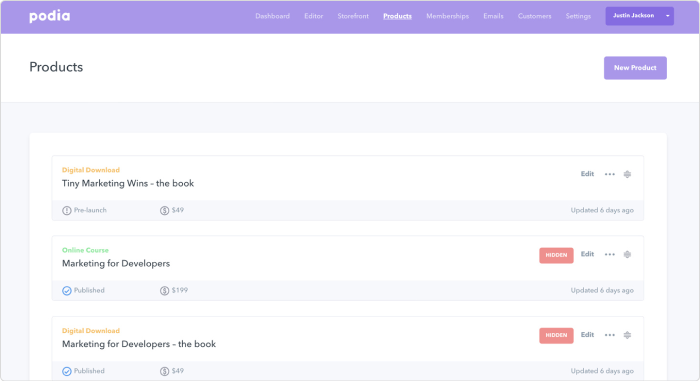
Podia is a relatively new name in the eLearning and e-commerce realm, but it’s gaining a lot of traction. This platform was designed with a creator-first mentality. It allows you to hurdle any potential technical obstacles associated with creating and hosting digital content. Whether your eLearning content comes in the form of video, audio, PDFs, cheat sheets, eBooks, or checklists, Podia’s got you covered.
Another noteworthy feature is that Podia offers “unlimited everything”. There are no extra costs associated with how many courses you’re hosting, students you’ve enrolled, storage, bandwidth, digital downloads, or memberships. Your monthly subscription fee covers everything.
Course creation
Given Podia’s minimalist and intuitive interface, all you have to do is upload your pre-designed content. The platform supports:
- MOV, MP4 video
- MP3 audio
- PNG, JPG, GIF files
- PDF, EPUB, and MOBI files
However, Podia is also limited in that it has no support for SCORM, Tin Can, or AICC packages. Therefore, like Thinkific and Teachable, it only supports courses that are low on the interactivity scale.
Since your eLearning content comes in the form of self-contained digital downloads, it’s hard to create multi-tiered courses that incorporate different kinds of multimedia. Still, it retains all the necessities of an eLearning platform – it allows you to add and edit course information, create sections and rearrange your content, and build simple quizzes.
Marketing and selling
From a marketing and sales perspective, with Podia, you can’t always get what you want – but you can get what you need. That means that this platform is relatively inflexible in terms of certain features, such as membership sites and payment gateways. For example, while Podia is one of the only platforms that allows you to host your membership site alongside your products — usually, they’re hosted separately — its membership sites only support the Stripe payment gateway, not even PayPal. There’s nothing worse than missing a sale due to incompatible or rigid payment options.
Still, Podia is one of the few platforms to date that lets you bundle memberships with courses. And it has highly-effective email and affiliate marketing capabilities.
What Podia is best suited for
Rather than businesses or training centers, Podia is best suited for entrepreneurs or individual course creators who have a host of digital products they’re looking to sell. If you’re looking for an all-in-one alternative to LearnDash, then Podia might be a good fit for you. However, it lacks the features of a fully-functional LMS platform. If you’re a training center or business with an academic focus, then you’ll be missing a lot of core components; you’ll be limited to digital downloads and one-tier courses.
Pricing
Podia is not only creator-friendly due to no transaction fees or hidden costs, but also because it’s priced so competitively. The pricing structure is simple – the Mover and Shaker plan.
- Mover plan. $39/month. In this plan, you can upload and sell online courses, digital downloads, and conduct email marketing. Everything is unlimited, and there are zero transaction fees. You also get access to 24/7 live customer support.
- Shaker plan. $79/month. This plan has everything in the Mover plan, but takes the e-commerce up a notch with extra features such as memberships, blogs, affiliate marketing, embedded check-out and third-party code snippets (e.g., Facebook, Pixel, Olark, etc.).
5. Kajabi
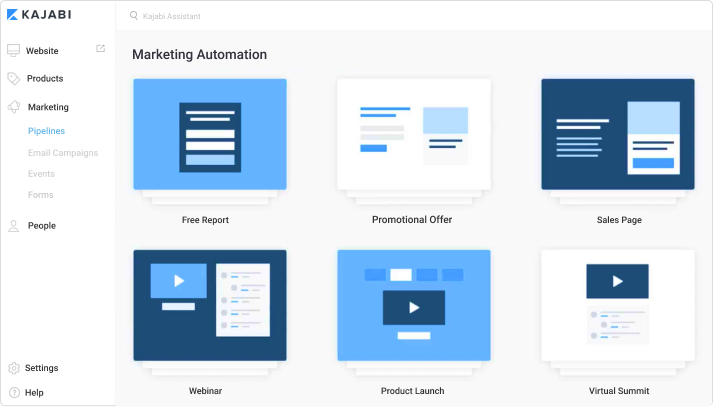
Kajabi sets itself apart from the other platforms by referring to its online courses as “digital products” and an “online business platform”. Therefore, while this platform allows you to create and host online products, develop a fully functional and customizable storefront with your business branding, and launch marketing campaigns, it might be hard to get the most out of it without a digital marketing background.
Course creation
To build a course, you simply need to upload the content and then rearrange it into a logical structure. Kajabi supports:
- All video files
- All audio files
- JPEG, PNG, and GIF images
- PDF, DOC, TXT, PPT files
After uploading your content, organize it into “categories” and “posts”, where a category’s akin to a module, and a post to a lesson.
Though, like most platforms, you can organize your course content (and website pages) by simply dragging and dropping it, Kajabi’s interface might require you to jump over a small learning hump. However, managing your courses is quite easy, because every content type you upload (e.g., video, mp3, PDF) gets its own “product blueprint”, which yields a sample structure with category and post “fillers”.
You can also add quizzes to your courses. The platform allows for multiple-choice, multiple response, and paragraph questions, but it doesn’t support advanced features like question banks or randomization.
Marketing and selling
Rather than just equipping you with the essential features to showcase your courses and process payments, Kajabi uniquely offers a full suite of digital marketing options. For example, you can adjust your pricing for any major currency, sell your courses on a fixed-price basis, subscription basis, or even a payment plan. You can also bundle your courses, and offer coupons or limited-time discounts.
However, Kajabi’s most innovative offering is its Sales Pipeline. All you have to do is choose from Kajabi’s preset “pipelines” and Kajabi will take care of the rest – your website pages, registration forms, email campaigns, etc.
What Kajabi is best suited for
Kajabi is an expensive option, but it might be worth the investment if you’re only working with individual content pieces. What it accomplishes in e-commerce, it falls short of in instructional design. For example, Kajabi doesn’t allow much in the way of the hierarchies or structures seen in multi-leveled courses. Therefore, you can’t create learning paths. It’s best suited for training centers and businesses that are selling short and simple eLearning products, as well as individuals who’d like to monetize their knowledge using an all-in-one platform.
Pricing
As mentioned, Kajabi’s price point is much higher than the other platforms we’ve reviewed here. But if you subscribe annually to any one of its plans, then you save 20%. Kajabi offers 3 plans — Basic, Growth, and Pro — with the Growth plan being the most popular.
For the most part, the plans all have the same features, but it increases the extent to which you can use each feature with each upgrade. For example, while all the plans allow for product hosting, pipelines, websites, contacts, and active members in the Basic plan, the Growth and Pro Packages also include advanced automation, white-labeling, and affiliate programs.
The prices are billed annually and are as follows:
- Basic. $119/month.
- Growth. $159/month.
- Pro. $319/month.
Final Thoughts
Overall, each of these platforms are popular options, but for different reasons. If you want or have a WordPress site and would like the convenience of hosting your courses all in one place, then LearnDash is for you. Note that you might have to overcome a slight learning curve if you’ve never used WordPress or aren’t that technically savvy.
iSpring Market is a great platform that’s easy to use and supports every file type, including high-interactivity courses in SCORM packages. Its advanced administrative features, the ability to create learning paths, and certification programs make it an excellent solution for training centers.
While Teachable and Thinkific are similar for the most part, Thinkific offers more flexible customization options for your website than Teachable. But while Teachable offers only one website theme, it allows for instructional-design heavy elements like receiving assignments.
If you’re creating one-tier courses with minimal structure, then Podia’s a solid bet. It allows you to focus on “creating” and takes care of the logistics behind marketing and selling your courses. However, it’s fairly hands-off. If you’d like more control over the look and feel of your storefront and marketing strategy, you’re going to feel constrained.
That’s where Kajabi sets itself apart. It places marketing and selling as higher priorities. If you’re a digital marketing guru who’d simply like to sell “digital products” instead of full-fledged courses with learning paths, then give Kajabi a try! You won’t fall short of options with your marketing strategy.
At the end of the day, your ideal platform all comes down to how you envision your course content and the overall direction of your business!
